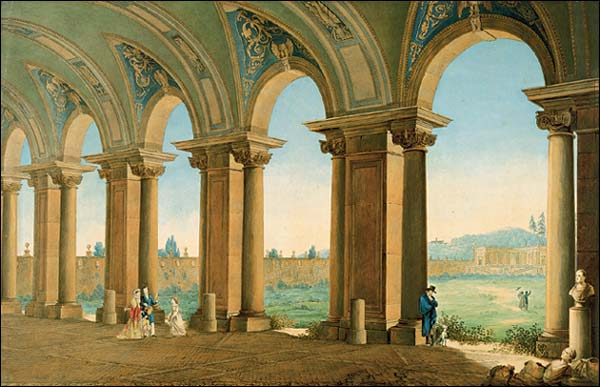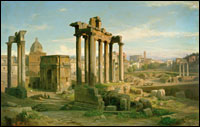Following the important exhibit it dedicated in 1990 to watercolorist Louis Decros, the Historical Museum of Lausanne presents, through loans from the Knébel family, the Castle of La Sarraz and the cantonal Museum of Beaux-Arts of Lausanne, some seventy works by François Keiserman –whom Ducros had called to Rome to assist him- and his cousins Jean-François, Charles-François Knébel and Titus Knébel. This family of painters, unanimously renowned in the past, worked for nearly 50 years in Italy and now will be our guides to explore the cultural panorama of the Vaud canton at a time when a « Vaudois » pictorial tradition emerged.
The Grand Tour
In the age of the Enlightenment, the economy in the Vaudois region was mainly rural. The mentality at the time in no way favored the development of art. As many of their contemporaries - Liotard, Brun, Bolomey, Sablet...- François Keiserman and his cousins only became successful when they expatriated themselves. Their works, all very fine and marked by great technical control, carry us to the time of the Grand Tour and were collected passionately by the travelling aristocrats of the time. During the XVIIIth century, Rome was the major stop of the Grand Tour - the mandatory initiatory voyage along the roads of History, Beauty and Knowledge - that led members of the high European society, the British in particular, through Europe.
Large format watercolors
Wealthy travelers liked to leave Rome with a souvenir from their stay. The production of « vedute » and other « topographic landscapes » underwent extraordinary growth, even though this genre was still looked down upon. During this transition period between neo-classicism and Romanticism the landscape began to be looked at as one of the components of History, linked to the classic Antiquity, and a source of multiple artistic interpretations. In order to represent it, an ever-growing number of painters settled in Rome used a technique hardly known until then, the watercolor. Louis Ducros played an essential part in its evolution towards the large format. With exceptional control, he lifted this technique to the level of oil painting, combining with precision and subtlety the picturesque and the ideal, bathing the whole thing in superb radiance.
Illustration: Titus Knébel, The Roman Forum ,1860, oil on canvas
© Musée romand, castle of La Sarraz, photos Musée historique de Lausanne (Historic Museum of Lausanne) /S. Pittet.
François Keiserman and his Knébel cousins
Keiserman followed Ducros’ footsteps, while creating his own style. At the end of the 1780s Ducros beckoned him to Rome. He set up on his own as early as 1792, was noticed by Prince Camillo Borghese who commissioned various watercolors, and took in some assistants to meet the requests from an ever-growing number of clients. He invited his cousin Jean-François Knébel (1789-1822). This collaboration lasted 15 years in spite of the master’s touchy character, and only seized at the young man’s premature death. He adopted and trained Charles-François Knébel (1810 – 1877). Conflicts inevitably arose between the master who wanted to perpetuate a “Keiserman” style, while the student wished to give his vedute a more personal touch. He was more of a traveler than his master, and painted Naples, Capri, the Abruzzi region… His views were frequently done in oil, his style was freer, closer to the tendencies initiated in France and in Italy. His son, Titus Knébel (1833-1898), painted the Roman countryside, often bathed in the sun, with tranquil details filled with charm, and often brilliant. In spite of the big movements that took over painting in Europe, he remained –like his father- a traditional painter who was satisfied with representing the Roman landscape he knew so well, without the commotions of modernity.
PUBLICATION
Exhibition catalogue Texts by William Hauptmann, Laurent Golay, 96 pages, 79 colour illustrations. Published by Musée historique de Lausanne. Price: CHF 39 + postage.
To see more illustrations, click on VERSION FRANCAISE at the top of this page
| 








